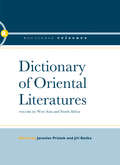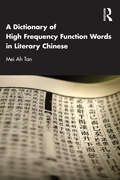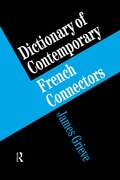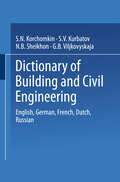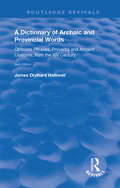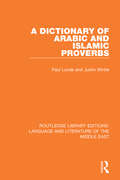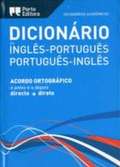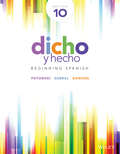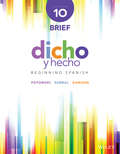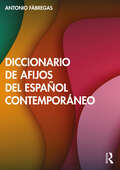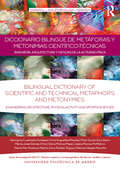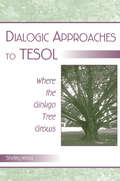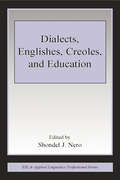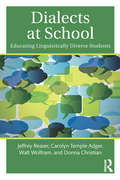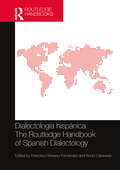- Table View
- List View
Dictionary of Oriental Literatures 3: West Asia and North Africa
by Jaroslav Průšek Jirí BeckaThe Dictionary of Oriental Literatures fills a long-felt gap in Western literature by presenting a concise summary, in three volumes and about 2000 articles, of practically all the literatures of Asia and North Africa. The first volume describes the Chinese, Tibetan, Japanese, Korean and Mongolian literatures; the second covers the area of South and South-East Asia, comprising, besides all literatures of India and Pakistan, those of Nepal, Bangladesh, Sri Lanka, Myanmar, Thailand, Cambodia, Vietnam, Indonesia, Malaysia and the Philippines; and the third is devoted to the numerous literatures of West Asia and North Africa. including on the one hand the literatures of the ancient Near East and Egypt, and on the other hand those of Central Asia and the Caucasus, of Turkey, Iran, Afghanistan and of the various Arab countries including Morocco, Tunisia and Algeria. The majority of entries give information about the life and work of the individual writers and poets of the classical, medieval and modern periods of the literatures included and also attempt to evaluate their writings from the historical and aesthetic point of view. The remaining articles describe literary terms, genres, forms, schools, movements etc. The Dictionary has been prepared by the Oriental Institute in Prague under the supervision of a Advisory Editorial Board of European and American scholars of international reputation and is unique in that it is the fruit of the collaboration of over 150 orientalists from many parts of the world. Contents include: Volume I East Asia: The Far East, including Chinese, Tibetan, Japanese, Korean and Mongolian literatures. Volume II South and South-East Asia: Ancient Indian, Assamese, Baluchi, Bengali, Gujarati, Hindi, Indian literature in English, Indo-Persian, Kannada, Kashmiri, Maithili, Malayalam, Marathi, Oriya, Panjabi, Pashto, Rajasthani, Sindhi, Tamil, Telugu and Urdu, Sinhalese, Nepali, Burmese, Thai, Cambodian, Malay and Indonesian, Javanese, Vietnamese and Philippines literatures. Volume III West Asia and North Africa: The Near East and Egypt, Central Asia and the Caucasus, Turkish, Persian, Afghan, Kurd and Arabic literatures, covering all the Arab states from Iraq in the East to Algeria in the West.
A Dictionary of High Frequency Function Words in Literary Chinese
by Mei Ah TanA Dictionary of High Frequency Function Words in Literary Chinese is the first comprehensive work on the subject that constitutes a new approach to teaching and learning by providing both a reference tool and a reader. This dictionary can serve both as a reference book and as an anthology for teaching and learning literary Chinese (the premodern written language) and both ancient and contemporary Chinese culture. It differs from the traditional design of dictionaries in that it includes detailed explanations, with examples, for different uses of the graphs most often used to represent function words in literary Chinese. To facilitate teaching and learning through association, the early meaning, extended meanings, and borrowed meanings for each graph are provided, along with explanations supported by the various stages of the historical development of the graph and other relevant research. Each word is grouped into the primary word class to which it belongs, based on its lexical or grammatical meanings, its collocations, and its function in a sentence. Modern idioms derived from words and phrases in the sample passages are provided in order to promote cultural knowledge and show the important role literary Chinese continues to play in everyday life. All Chinese words are provided with Putonghua romanization to facilitate learning and recall through sound; special pronunciations are explained. This book can be used as a textbook, as extended reading, or as a reference work for undergraduate or graduate classes on literary/classical Chinese, Chinese manuscript studies, Chinese language and culture, Putonghua, translation studies, or even linguistics. It can also be used as an anthology from which the teacher can select passages for students to study.
A Dictionary of French Connectors
by James GrieveConnecting words and phrases are essential for discussion, clarity and fluency in any language. French is particularly reliant on connecting language: also and in fact have around 15 equivalent words and expressions in French. This is the first French-English dictionary to focus on this fascinating and crucial part of the language. The dictionary presents nearly 200 full entries in alphabetical order, including: de plus; et ce; or; c'est dire que; en fait; au total; voila. Entries define, discuss and exemplify the whole range of connecting language in French. 2000 examples add further clarity and are chosen from a wide range of registers and mainly contemporary prose.
A Dictionary of French Connectors
by James GrieveConnecting words and phrases are essential for discussion, clarity and fluency in any language. French is particularly reliant on connecting language: also and in fact have around 15 equivalent words and expressions in French. This is the first French-English dictionary to focus on this fascinating and crucial part of the language. The dictionary presents nearly 200 full entries in alphabetical order, including: de plus; et ce; or; c'est dire que; en fait; au total; voila. Entries define, discuss and exemplify the whole range of connecting language in French. 2000 examples add further clarity and are chosen from a wide range of registers and mainly contemporary prose.
Dictionary of Building and Civil Engineering: English, German, French, Dutch, Russian
by S. N. Korchomkin S. V. Kurbatov N. B. Sheikhon G. B. ViljkovyskajaIn the last few decades civil engineering has undergone substantial technological change which has, naturally, been reflected in the terminology employed in the industry. Efforts are now being made in many countries to bring about a systematization and unification of technical terminology in general, and that of civil engineering in particular. The publication of a multilingual dictionary of civil engineering terms has been necessitated by the expansion of international cooperation and information exchange in this field, as well as by the lack of suitable updated bilingual dictionaries. This Dictionary contains some 14.000 English terms together with their German, French, Dutch and Russian equivalents, which are used in the main branches of civil engineering and relate to the basic principles of structural design and calculations (the elasticity theory, strength of materials, soil mechanics and other allied technical disciplines); to buildings and installations, structures and their parts, building materials and prefabrications, civil engineering technology and practice, building and road construction machines, construction site equipment, housing equipment and fittings (including modern systems of air conditioning); as well as to hydrotechnical and irrigation constructions. The Dictionary also includes a limited number of basic technical expressions and terms relating to allied disciplines such as architecture and town planning, as well as airfield, railway and underground construction. The Dictionary does not list trade names of building materials, parts and machines or the names of chemical compounds. Nor does it give adverbial, adjective or verbal terms.
A Dictionary of Archaic and Provincial Words: Obsolete Phrases, Proverbs, and Ancient Customs, from the XIV Century (Routledge Revivals)
by James Orchard HalliwellSo far I may be permitted to speak without intrenching on the limits of criticism. A work containing more than 50,000 words, many of which have never appeared even in scattered glossaries, and illustrated, with very few exceptions, by original authorities, much contain valuable material for the philogist, even if disfigured by errors. With respect to the latter contingency, I am not acquainted with any glossary, comprising merely a few hundred words which does not contain blunders, although in many instances the careful attention of the editor has been specially directed to the task. Can I then anticipate that in a field so vast that no single life would sufice for a minute examination of every object, I could have escaped proportionate liabilities? That such may be pointed out I have little doubt, notwithstanding the pains to prevent their occurrence, but it will be manifestly unfair to make them the test of merit, or thence to pronounce a judgement on the accuracy of the whole.
A Dictionary of Archaic and Provincial Words: Obsolete Phrases, Proverbs, and Ancient Customs, from the XIV Century (Routledge Revivals)
by James Orchard HalliwellSo far I may be permitted to speak without intrenching on the limits of criticism. A work containing more than 50,000 words, many of which have never appeared even in scattered glossaries, and illustrated, with very few exceptions, by original authorities, much contain valuable material for the philogist, even if disfigured by errors. With respect to the latter contingency, I am not acquainted with any glossary, comprising merely a few hundred words which does not contain blunders, although in many instances the careful attention of the editor has been specially directed to the task. Can I then anticipate that in a field so vast that no single life would sufice for a minute examination of every object, I could have escaped proportionate liabilities? That such may be pointed out I have little doubt, notwithstanding the pains to prevent their occurrence, but it will be manifestly unfair to make them the test of merit, or thence to pronounce a judgement on the accuracy of the whole.
A Dictionary of Arabic and Islamic Proverbs
by Paul Lunde Justin WintleOne of the quickest ways to understand a people or a culture is to learn their proverbs. This anthology, first published in 1984, compiles in dictionary form proverbs from the Islamic world, particularly the Middle East and North Africa. The Arabs were the first to gather and annotate their own proverbs – the earliest collections date from the n
A Dictionary of Arabic and Islamic Proverbs
by Paul Lunde Justin WintleOne of the quickest ways to understand a people or a culture is to learn their proverbs. This anthology, first published in 1984, compiles in dictionary form proverbs from the Islamic world, particularly the Middle East and North Africa. The Arabs were the first to gather and annotate their own proverbs – the earliest collections date from the n
Dicionário Inglês-Português/Português-Inglês (Dicionários Académicos)
by Porto EditoraImperative dictionary for Portuguese and English learning. - Near 131.000 translations - Over 70.000 entries, examples, and idiomatic expressions
Dicionário Académico Inglês-Português/Português-Inglês (Dicionários Académicos)
by Porto EditoraImperative dictionary for Portuguese and English learning. - Near 131.000 translations - Over 70.000 entries, examples, and idiomatic expressions
Dicho y hecho: Beginning Spanish
by Kim Potowski Silvia Sobral Laila M. DawsonEl recurso de punto de referencia para el aprendizaje de español en el siglo 21 Ahora la 10ª edición, Dicho y hecho: Beginning Spanish ofrece un programa de lenguaje innovativo el cual ha sido diseñado para estudiantes de hoy en día. Este enfoque de aprender español es fácil de implantar y a través de los años ha demostrado ser innovatico y muy efectivo. La gramática es presentada con explicaciones precisas, simple, con gráficos claros y abundantes frases de ejemplos que establecen conexiones inmediatas entre formas y el uso en la comunicación. Ofrece un conjunto de sistemas de aprendizaje en línea para hacer accesible el aprendizaje Basado en hacer el proceso muy efectivo, flexible y agradable Se centra en los elementos esenciales necesarios para dominar el lenguaje a nivel de principiante y obteniendo conciencia cultural Diverso y atractivo, Dicho y hecho combina una variedad de actividades probadas e innovativas que envuelven todas las habilidades del lenguaje. ENGLISH DESCRIPTION The landmark resource for learning Spanish in the 21st Century Now in its 10th edition, Dicho y hecho: Beginning Spanish offers an innovative language program designed for today's students. This approach to learning Spanish is easy-to-implement and over the years has proven to be innovative and highly effective. Grammar is presented with precise, simple explanations, clear charts, and abundant example sentences that draw immediate connections between forms and their communicative use. Offers a suite of online learning systems to make learning accessible Based on a highly effective, flexible and enjoyable Focuses on the essentials needed to master beginner level language and cultural awareness Diverse and engaging, Dicho y hecho combines an array of tested and innovative activities that involve all language skills.
Dicho y hecho: Beginning Spanish
by Kim Potowski Silvia Sobral Laila M. DawsonLa breve edición del recurso de punto de referencia para el aprendizaje del español en el siglo 21 Esta breve versión de Dicho y hecho: Beginning Spanish le da a los estudiantes un programa de lenguaje comprobado que han sido probados con el tiempo. Este enfoque para el aprendizaje de español es fácil de implementar, y con los años ha demostrado ser innovadora y altamente eficaz. La gramática se presenta con explicaciones precisas, simples, con gráficos claros y abundantes frases de ejemplos que establecen conexiones inmediatas entre formas y su uso en la comunicación. Incluye sistemas de aprendizaje en línea para hacer el aprendizaje flexible y fácil Basado en un sistema altamente eficaz y agradable Destaca los elementos esenciales para dominar el lenguaje a nivel de principiante y entender la cultural Dicho y hecho combina una variedad de actividades comprobadas e que mejorar todas las habilidades del lenguaje. ENGLISH DESCRIPTION The brief edition of the landmark resource for learning Spanish in the 21st Century The brief version of Dicho y hecho: Beginning Spanish gives students a provenlanguage program that has been tested over time. This approach to learning Spanish is easy to implement, and over the years has proven to be innovative and highly effective. Grammar is presented with precise, simple explanations, clear charts, and abundant example sentences that draw immediate connections between forms and their communicative use. Includes online learning systems to make learning flexible and easy Based on a highly effective and enjoyable system Highlights the essentials for mastering beginner level language and cultural awareness Dicho y hecho combines an array of tested and innovative activities that involve all language skills.
Diccionario de afijos del español contemporáneo
by Antonio FábregasEl Diccionario de afijos del español contemporáneo es el primer estudio completo y sistemático de los morfemas que el español utiliza para la formación de palabras. En esta obra se presenta en detalle cada afijo utilizado para construir palabras en español. Este completo diccionario destaca por sus descripciones de las principales propiedades de todos los afijos contemporáneos del español, incluyendo su comportamiento gramatical, clases de bases, significados, comportamiento fonológico y relación con otros afijos. El estudio se complementa con una bibliografía, un glosario de términos y apéndices que clasifican los afijos según diversos criterios. El formato de diccionario, organizado alfabéticamente, permite una consulta rápida y sencilla, y será especialmente útil para investigadores y estudiantes avanzados de morfología española. Diccionario de afijos del español contemporáneo is the first comprehensive and systematic study of the elements that Spanish uses for word formation. Every affix used to build words in Spanish is presented here in detail. This comprehensive dictionary is unique for its descriptions of the main properties of all contemporary Spanish affixes, including their grammatical behavior, base classes, meanings, phonological behavior, and relation to other affixes. The study is complemented by a bibliography, a glossary of terms, and appendices that classify the affixes based on various criteria. The dictionary format, organised alphabetically, allows for quick and easy reference and will be of particular use to researchers and advanced students of Spanish morphology.
Diccionario de afijos del español contemporáneo
by Antonio FábregasEl Diccionario de afijos del español contemporáneo es el primer estudio completo y sistemático de los morfemas que el español utiliza para la formación de palabras. En esta obra se presenta en detalle cada afijo utilizado para construir palabras en español. Este completo diccionario destaca por sus descripciones de las principales propiedades de todos los afijos contemporáneos del español, incluyendo su comportamiento gramatical, clases de bases, significados, comportamiento fonológico y relación con otros afijos. El estudio se complementa con una bibliografía, un glosario de términos y apéndices que clasifican los afijos según diversos criterios. El formato de diccionario, organizado alfabéticamente, permite una consulta rápida y sencilla, y será especialmente útil para investigadores y estudiantes avanzados de morfología española. Diccionario de afijos del español contemporáneo is the first comprehensive and systematic study of the elements that Spanish uses for word formation. Every affix used to build words in Spanish is presented here in detail. This comprehensive dictionary is unique for its descriptions of the main properties of all contemporary Spanish affixes, including their grammatical behavior, base classes, meanings, phonological behavior, and relation to other affixes. The study is complemented by a bibliography, a glossary of terms, and appendices that classify the affixes based on various criteria. The dictionary format, organised alphabetically, allows for quick and easy reference and will be of particular use to researchers and advanced students of Spanish morphology.
Diccionario Bilingüe de Metáforas y Metonimias Científico-Técnicas: Ingeniería, Arquitectura y Ciencias de la Actividad Física
by Georgina Cuadrado EsclapezDiccionario Bilingüe de Metáforas y Metonimias Científico-Técnicas presents the extensive range of metaphoric and metonymic terms and expressions that are commonly used within the fields of science, engineering, architecture and sports science. Compiled by a team of linguists working across a range of technical schools within the Universidad Politécnica de Madrid, this practical dictionary fills a gap in the field of technical language and will be an indispensable reference for students within the fields of science, engineering or sports science seeking to work internationally and for translators and interpreters working in these specialist fields.
Diccionario Bilingüe de Metáforas y Metonimias Científico-Técnicas: Ingeniería, Arquitectura y Ciencias de la Actividad Física
by Georgina Cuadrado EsclapezDiccionario Bilingüe de Metáforas y Metonimias Científico-Técnicas presents the extensive range of metaphoric and metonymic terms and expressions that are commonly used within the fields of science, engineering, architecture and sports science. Compiled by a team of linguists working across a range of technical schools within the Universidad Politécnica de Madrid, this practical dictionary fills a gap in the field of technical language and will be an indispensable reference for students within the fields of science, engineering or sports science seeking to work internationally and for translators and interpreters working in these specialist fields.
Dialogic Approaches to TESOL: Where the Ginkgo Tree Grows
by Shelley WongThis book locates dialogic pedagogy within the history of TESOL approaches and methods in which the communicative approach has been the dominant paradigm. Dialogic inquiry in the form of story telling, oral histories, and knowledge from the ground up and from the margins has much to offer the field. In dialogic approaches, the teacher and students learn in community and the students' home languages and cultures, their families and communities, are seen as resources.Dialogic Approaches to TESOL: Where the Ginkgo Tree Grows explores teacher research, feminist contributions to voice, social identity and dialogic pedagogy, and the role of teachers, students, families, and communities as advocates and change agents. After a brief history of TESOL methods and an introduction to dialogic pedagogy, four features of dialogic approaches to TESOL are identified and discussed: learning in community, problem-posing, learning by doing, and who does knowledge serve? The main text in each chapter considers a single topic related to the concept of dialogic pedagogy. Branching text leads to related discussions without losing the main point of the chapter. This structure allows readers to become well-rooted in each component of dialogic pedagogy and to "branch out" into deeper philosophic understandings as well as actual practices across a range of contexts.Dialogic Approaches to TESOL offers a place for dialogue and reflection on the prospects for transforming educational institutions to serve those who have historically been excluded and marginalized. It provides questions, frameworks, and resources for those who are just beginning in the field and for U.S.-based educators who want to bring critical multicultural and multilingual perspectives into language arts, reading and literacy education.
Dialogic Approaches to TESOL: Where the Ginkgo Tree Grows
by Shelley WongThis book locates dialogic pedagogy within the history of TESOL approaches and methods in which the communicative approach has been the dominant paradigm. Dialogic inquiry in the form of story telling, oral histories, and knowledge from the ground up and from the margins has much to offer the field. In dialogic approaches, the teacher and students learn in community and the students' home languages and cultures, their families and communities, are seen as resources.Dialogic Approaches to TESOL: Where the Ginkgo Tree Grows explores teacher research, feminist contributions to voice, social identity and dialogic pedagogy, and the role of teachers, students, families, and communities as advocates and change agents. After a brief history of TESOL methods and an introduction to dialogic pedagogy, four features of dialogic approaches to TESOL are identified and discussed: learning in community, problem-posing, learning by doing, and who does knowledge serve? The main text in each chapter considers a single topic related to the concept of dialogic pedagogy. Branching text leads to related discussions without losing the main point of the chapter. This structure allows readers to become well-rooted in each component of dialogic pedagogy and to "branch out" into deeper philosophic understandings as well as actual practices across a range of contexts.Dialogic Approaches to TESOL offers a place for dialogue and reflection on the prospects for transforming educational institutions to serve those who have historically been excluded and marginalized. It provides questions, frameworks, and resources for those who are just beginning in the field and for U.S.-based educators who want to bring critical multicultural and multilingual perspectives into language arts, reading and literacy education.
Dialects, Englishes, Creoles, and Education (ESL & Applied Linguistics Professional Series)
by Shondel J. NeroThis volume brings together a multiplicity of voices--both theoretical and practical--on the complex politics, challenges, and strategies of educating students--in North America and worldwide--who are speakers of diverse or nonstandard varieties of English, creoles, and hybrid varieties of English, such as African American Vernacular English, Caribbean Creole English, Tex Mex, West African Pidgin English, and Indian English, among others. The number of such students is increasing as a result of the spread of English, internal and global migration, and increased educational access. Dialects, Englishes, Creoles, and Education offers:*a sociohistorical perspective on language spread and variation;*analysis of related issues such as language attitudes, identities, and prescribed versus actual language use; and*practical suggestions for pedagogy.Pedagogical features: Key points at the beginning of each chapter help focus the reader and provide a framework for reading, writing, reflection, and discussion; chapter-end questions for discussion and reflective writing engage and challenge the ideas presented and encourage a range of approaches in dealing with language diversity. Collectively, the chapters in this volume invite educators, researchers, and students, across the fields of TESOL, applied linguistics, sociolinguistics, English, literacy, and language education, to begin to consider and adopt context-specific policies and practices that will improve the language development and academic performance of linguistically diverse students.
Dialects, Englishes, Creoles, and Education (ESL & Applied Linguistics Professional Series)
by Shondel J. NeroThis volume brings together a multiplicity of voices--both theoretical and practical--on the complex politics, challenges, and strategies of educating students--in North America and worldwide--who are speakers of diverse or nonstandard varieties of English, creoles, and hybrid varieties of English, such as African American Vernacular English, Caribbean Creole English, Tex Mex, West African Pidgin English, and Indian English, among others. The number of such students is increasing as a result of the spread of English, internal and global migration, and increased educational access. Dialects, Englishes, Creoles, and Education offers:*a sociohistorical perspective on language spread and variation;*analysis of related issues such as language attitudes, identities, and prescribed versus actual language use; and*practical suggestions for pedagogy.Pedagogical features: Key points at the beginning of each chapter help focus the reader and provide a framework for reading, writing, reflection, and discussion; chapter-end questions for discussion and reflective writing engage and challenge the ideas presented and encourage a range of approaches in dealing with language diversity. Collectively, the chapters in this volume invite educators, researchers, and students, across the fields of TESOL, applied linguistics, sociolinguistics, English, literacy, and language education, to begin to consider and adopt context-specific policies and practices that will improve the language development and academic performance of linguistically diverse students.
Dialects at School: Educating Linguistically Diverse Students
by Jeffrey Reaser Carolyn Temple Adger Walt Wolfram Donna ChristianLike its predecessor, Dialects in Schools and Communities, this book illuminates major language-related issues that educational practitioners confront, such as responding to dialect related features in students’ speech and writing, teaching Standard English, teaching students about dialects, and distinguishing dialect difference from language disorders. It approaches these issues from a practical perspective rooted in sociolinguistic research, with a focus on the research base for accommodating dialect differences in schools. Expanded coverage includes research on teaching and learning and attention to English language learners. All chapters include essential information about language variation, language attitudes, and principles of handling dialect differences in schools; classroom-based samples illustrating the application of these principles; and an annotated resources list for further reading. The text is supported by a Companion Website (www.routledge.com/cw/Reaser) providing additional resources including activities, discussion questions, and audio/visual enhancements that illustrate important information and/or pedagogical approaches. Comprehensive and authoritative, Dialects at School reflects both the relevant research bases in linguistics and education and educational practices concerning language variation. The problems and examples included are authentic, coming from the authors’ own research, observations and interactions in public school classrooms, and feedback in workshops. Highlights include chapters on oral language and reading and writing in dialectally diverse classrooms, as well as a chapter on language awareness for students, offering a clear and compelling overview of how teachers can inspire students to learn more about language variation, including their own community language patterns. An inventory of dialect features in the Appendix organizes and expands on the structural descriptions presented in the chapters.
Dialects at School: Educating Linguistically Diverse Students
by Jeffrey Reaser Carolyn Temple Adger Walt Wolfram Donna ChristianLike its predecessor, Dialects in Schools and Communities, this book illuminates major language-related issues that educational practitioners confront, such as responding to dialect related features in students’ speech and writing, teaching Standard English, teaching students about dialects, and distinguishing dialect difference from language disorders. It approaches these issues from a practical perspective rooted in sociolinguistic research, with a focus on the research base for accommodating dialect differences in schools. Expanded coverage includes research on teaching and learning and attention to English language learners. All chapters include essential information about language variation, language attitudes, and principles of handling dialect differences in schools; classroom-based samples illustrating the application of these principles; and an annotated resources list for further reading. The text is supported by a Companion Website (www.routledge.com/cw/Reaser) providing additional resources including activities, discussion questions, and audio/visual enhancements that illustrate important information and/or pedagogical approaches. Comprehensive and authoritative, Dialects at School reflects both the relevant research bases in linguistics and education and educational practices concerning language variation. The problems and examples included are authentic, coming from the authors’ own research, observations and interactions in public school classrooms, and feedback in workshops. Highlights include chapters on oral language and reading and writing in dialectally diverse classrooms, as well as a chapter on language awareness for students, offering a clear and compelling overview of how teachers can inspire students to learn more about language variation, including their own community language patterns. An inventory of dialect features in the Appendix organizes and expands on the structural descriptions presented in the chapters.
Dialectología hispánica / The Routledge Handbook of Spanish Dialectology (Routledge Spanish Language Handbooks)
by Francisco Moreno-Fernández Rocío CaravedoDialectología hispánica / The Routledge Handbook of Spanish Dialectology es una obra coral que presenta las últimas investigaciones sobre las variedades actuales de la lengua espanola en todas sus geografías, sumando los conocimientos de un importante número de especialistas en la materia. Este volumen consta de 49 capítulos, distribuidos en cuatro secciones, que ofrecen información actualizada sobre la realidad dialectal del espanol y reflejan los conocimientos disponibles sobre la lengua y sus variedades. Este libro, amplio e innovador, explora el modo en que diversas especialidades lingüísticas se interesan por la variación dialectal, desde la historia hasta la informática, pasando por la fonética, la gramática y la lexicografía, entre otras disciplinas. Desde una interpretación multidimensional de los espacios dialectales, este manual asocia la variación geolingüística no sólo con la historia y la sociología, sino también con factores étnicos, estilísticos y cognitivos. Esta obra es idónea para todos los investigadores interesados en la lingüística del espanol, la variación lingüística y el contacto de lenguas, así como para estudiantes de grado y posgrado. En ella se explora en profundidad la dialectología del espanol en todas las expresiones del espacio hispanohablante. Dialectología hispánica / The Routledge Handbook of Spanish Dialectology is a choral work that provides the latest research on the current varieties of the Spanish language in all its geographies, collating expertise from a wealth of leading scholars in the subject. This volume is comprised of 49 chapters, distributed in four sections, which offer up-to-date information on the dialectal reality of Spanish and reflect the knowledge available on the language and its varieties. This comprehensive and innovative book explores the way in which various linguistic specialities are interested in dialectal variation, from history to computer science, including phonetics, grammar and lexicography, among other disciplines. Displaying a commitment to a multidimensional view of dialectal spaces, this handbook associates geolinguistic variation not only with history and sociology, but also with ethnic, stylistic and cognitive factors. Presenting an in-depth exploration of Spanish dialectology in all its expressions across the Spanish-speaking space, this resource is ideal for all researchers interested in Spanish linguistics, linguistic variation and language contact, as well as for undergraduate and graduate students.
Dialectología hispánica / The Routledge Handbook of Spanish Dialectology (Routledge Spanish Language Handbooks)
by Francisco Moreno-Fernández Rocío Caravedo Manel Lacorte Javier Muñoz-BasolsDialectología hispánica / The Routledge Handbook of Spanish Dialectology es una obra coral que presenta las últimas investigaciones sobre las variedades actuales de la lengua espanola en todas sus geografías, sumando los conocimientos de un importante número de especialistas en la materia. Este volumen consta de 49 capítulos, distribuidos en cuatro secciones, que ofrecen información actualizada sobre la realidad dialectal del espanol y reflejan los conocimientos disponibles sobre la lengua y sus variedades. Este libro, amplio e innovador, explora el modo en que diversas especialidades lingüísticas se interesan por la variación dialectal, desde la historia hasta la informática, pasando por la fonética, la gramática y la lexicografía, entre otras disciplinas. Desde una interpretación multidimensional de los espacios dialectales, este manual asocia la variación geolingüística no sólo con la historia y la sociología, sino también con factores étnicos, estilísticos y cognitivos. Esta obra es idónea para todos los investigadores interesados en la lingüística del espanol, la variación lingüística y el contacto de lenguas, así como para estudiantes de grado y posgrado. En ella se explora en profundidad la dialectología del espanol en todas las expresiones del espacio hispanohablante. Dialectología hispánica / The Routledge Handbook of Spanish Dialectology is a choral work that provides the latest research on the current varieties of the Spanish language in all its geographies, collating expertise from a wealth of leading scholars in the subject. This volume is comprised of 49 chapters, distributed in four sections, which offer up-to-date information on the dialectal reality of Spanish and reflect the knowledge available on the language and its varieties. This comprehensive and innovative book explores the way in which various linguistic specialities are interested in dialectal variation, from history to computer science, including phonetics, grammar and lexicography, among other disciplines. Displaying a commitment to a multidimensional view of dialectal spaces, this handbook associates geolinguistic variation not only with history and sociology, but also with ethnic, stylistic and cognitive factors. Presenting an in-depth exploration of Spanish dialectology in all its expressions across the Spanish-speaking space, this resource is ideal for all researchers interested in Spanish linguistics, linguistic variation and language contact, as well as for undergraduate and graduate students.
